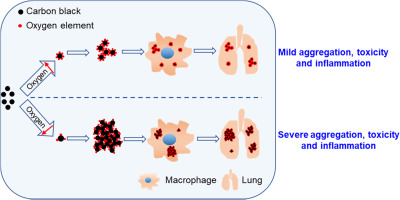Ecotoxicology and Environmental Safety ( IF 6.2 ) Pub Date : 2018-01-04 , DOI: 10.1016/j.ecoenv.2017.12.044 Yakun Wu , Yifan Guo , Haoyang Song , Wei Liu , Yi Yang , Yajun Liu , Nan Sang , Yi Y. Zuo , Sijin Liu

|
In spite of the considerable efforts invested to understand the environmental health and safety (EHS) impacts of ultrafine particles, such as the representative PM2.5, there are still significant knowledge gaps to be filled. No conclusive understandings have been obtained about the physicochemical determinants in accounting for differential adverse outcomes. Here we compared the cytotoxicity of four carbon black (CB) particles with similar physicochemical properties except for their oxygen contents (C824455 < C1864 < Printex U < SB4A). We found that these four CB particles manifested in vitro and in vivo cytotoxicity reversely related to their oxygen contents, namely a hierarchy of cytotoxicity: C824455 > C1864 > Printex U > SB4A. Among these CB particles, the most significant lung injury (e.g. collapses and inflammation) and macrophagic activation were found for C824455 and C1864, in particular for C824455. All these differences in toxicity profiles, including in vitro and in vivo cytotoxicity, pro-inflammatory effects and direct damages to the lung epithelia, should be (at least partially) ascribed to the oxygen content in these CB particles that in turn determined their transformation, i.e. the different aggregation states. Nonetheless, PM2.5 likewise caused severe in vivo and in vitro toxicities to the lung cells and macrophages. This study thus offers more insights into the structure-activity relationship (SAR) and opens a new avenue to elucidate the physicochemical determinants in evoking lung injuries by ultrafine airborne particles.
中文翻译:

氧含量决定炭黑颗粒的生物反应性和毒性
尽管付出了巨大的努力来理解超细颗粒(例如代表性的PM2.5)对环境健康和安全(EHS)的影响,但仍然存在大量的知识空白。尚无关于理化决定因素在解释不良不良后果方面的结论性认识。在这里,我们比较了四个具有相似理化特性的碳黑(CB)颗粒的细胞毒性,除了它们的含氧量(C824455 <C1864 <Printex U <SB4A)。我们发现这四个CB粒子在体外和体内均表现出来细胞毒性与其氧含量成反比,即细胞毒性等级:C824455> C1864> Printex U> SB4A。在这些CB颗粒中,对于C824455和C1864,特别是对于C824455,发现了最明显的肺部损伤(例如塌陷和炎症)和巨噬细胞活化。所有这些毒性特征的差异,包括体外和体内的细胞毒性,促炎作用以及对肺上皮的直接损害,都应(至少部分地)归因于这些CB颗粒中的氧含量,这些氧含量又决定了它们的转化,即不同的聚合状态。尽管如此,PM2.5同样会在体内和体外引起严重的疾病。对肺细胞和巨噬细胞有毒性。因此,这项研究为结构-活性关系(SAR)提供了更多见识,并开辟了一条新途径,阐明了超细空气中颗粒物引起肺部损伤的理化决定因素。











































 京公网安备 11010802027423号
京公网安备 11010802027423号